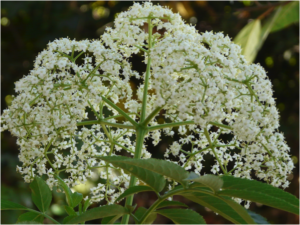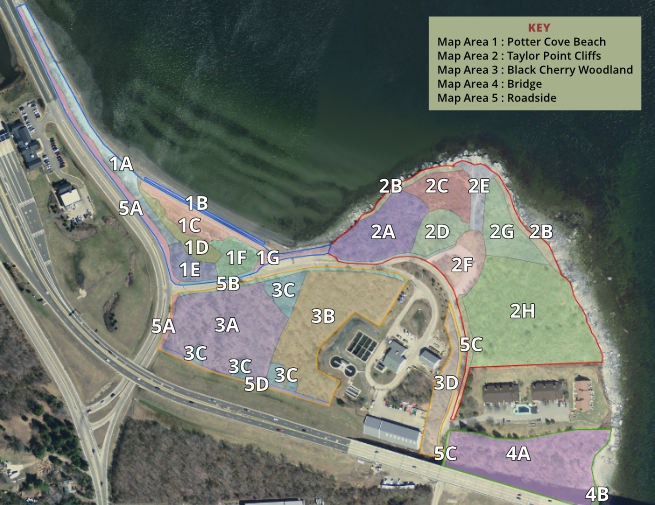Common Name: Black Elderberry, Common Elderberry
Specific Name: Sambucus nigra, Sambucus Canadensis
Known Occurrence at Taylor Point:
Map areas: Woodlands 3A, Woodlands 3B, Woodlands 3C
Category: Native, Shrub

Ecological Considerations:
The elderberry is an erect, thicket-forming, somewhat woody shrub, 4-12 feet tall, with smooth yellowish-gray branchlets and white pith. Compound leaves are set oppositely in pairs in a feather-like arrangement. The leaf surface is bright green. The oval to lance-shaped leaflets are up to 6″ long and 2 1/2″ wide, with finely serrated margins. They are abruptly narrowed at the tip and lopsidedly narrowed or rounded at the base. Leaflets are usually held on short stalks; the terminal leaflet is on a longer stalk. Numerous 1/4″ fragrant white flowers, emerge from late June into August. The terminal clusters of flowers, measuring 4″-10″ across, are broad, flat or slightly rounded and long-stalked. Flowers usually develop in the second-year on older canes, and are arranged in branched clusters of 5.
Fruits ripen from late July into September. They are round, slightly bitter, edible purple-black berries with crimson juice. Each is less than 1/4″ across, borne in large clusters. Each berry contains 3-5 small seeds. Seed dispersal occurs from July to October, usually through vigorous ingestion by birds and mammals
Map areas where this plant can be used for revegetation:
Black cherry woodland – 3A
Black cherry woodland – 3B
Black cherry woodland – 3C
Propagation Mechanisms/Strategies for Encouraging its Establishment:
Elderberry naturally reproduces from seeds, sprouts, layers, and root suckers.
Best Planting Practices/Options and Pros and Cons of Options:
Elderberry occupies well-drained, slightly acid soil bordering streams, and in the adjacent bottomlands, but also grows on gray forest soils and muck. This shrub is widespread and abundant. Elderberry grows best in full sunlight. Once established, elders soon outdistance herbaceous competition. Thickets of elderberry are replaced by more shade-tolerant species during the later stages of forest succession, but individual plants and small runners will persist under a forest canopy.
Key Issues Regarding its Ecology ( e.g. Which Invasives Threaten it, What Conditions Favor it)
Associated Ecological Benefits:
At least 50 species of songbirds, upland game birds, and small mammals relish the fruit of elderberry during summer and early fall. White-tailed deer browse the twigs, foliage and fruit during the summer. American elder is outstanding as nesting cover for small birds. During summer, the partial shade under American elder promotes a dense ground cover of grasses and forbs that offers good loafing or feeding areas for broods of young pheasants and quail.
Elderberry can be used for erosion control on moist sites.
Availability of Locally Sourced Seeds and Plants:
Roots & Shoots Garden Center info
The Farmer’s Daughter info
Wildwood Nurseries
Case Studies of Native Plant Establishment Efforts/Lessons Learned:
Additional Photos:

Sources cited:
Search at Rhode Island Native Plant Guide
USDA Fact Sheets
Key Words:
Native
Shrub
Non-Invasive
Black Elderberry
Common Elder
Common Elderberry
Sambucus nigra
Sambucus Canadensis
Sambucus nigra ssp. canadensis
